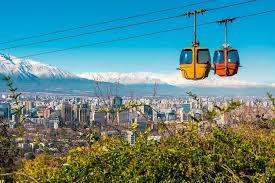What time zone is Santiago de Chile in?

What time zone is Santiago de Chile in?
What time zone is Santiago de Chile in? Santiago de Chile operates in the Chile Standard Time zone, adjusting for daylight saving time during certain months of the year.
Santiago de Chile follows Chile Standard Time (CLT) and observes daylight saving time, which impacts its overall time zone throughout the year.
Chile Standard Time (CLT)
Santiago is primarily in Chile Standard Time (CLT), which is UTC -4. This time zone remains in effect during most of the year, aligning with many other countries in South America.
Daylight Saving Time (DST)
Santiago observes Daylight Saving Time (DST). From September to April, the city moves to Chile Summer Time (CLST), which is UTC -3, giving the region longer daylight hours during the warmer months.
The Start of Daylight Saving Time
Daylight Saving Time in Santiago begins on the first Saturday of September. At this point, the clocks are moved one hour forward, marking the transition to the Chile Summer Time (CLST) period.
The End of Daylight Saving Time
Daylight Saving Time ends in Santiago in April. Clocks are turned back one hour, returning to Chile Standard Time (CLT). This helps the city adjust to shorter daylight hours in the fall and winter months.
Time Difference with Other Countries
Santiago’s time zone places it in a unique position within the Americas. It is typically two hours ahead of Eastern Standard Time (EST) in the U.S. when Daylight Saving Time is not in effect.
Impact on International Business
The time zone of Santiago influences international business, particularly with countries in Europe and North America. Business hours align with other major cities in Latin America, allowing smoother communications with global partners.
Differences with Neighboring Countries
Chile shares its time zone with some neighboring countries, such as Bolivia and Paraguay, but other countries like Argentina or Peru have slight time differences, which can impact regional coordination.
Time Zone Confusion
Because Santiago switches to Daylight Saving Time while some neighboring countries do not, there can be occasional confusion regarding the time difference, especially during the transition periods when countries are on different times.
Use of Time Zones in Chile
Chile is divided into several time zones due to its geographical size. While Santiago follows Chile Standard Time, some remote areas, such as Easter Island, use a different time zone, creating a time zone discrepancy within the country.
The Role of Time Zones in Travel
For travelers to and from Santiago, understanding the time zone is crucial. Adjusting to the time difference can help minimize jet lag, especially when crossing multiple time zones between continents.
Adjustments for Seasonal Changes
Santiago’s seasonal time adjustments ensure that the city optimizes daylight during the summer months. This practice helps conserve energy and allows for longer evenings, aligning daily activities with daylight availability.
Coordination with Global Events
The time zone of Santiago is also important when coordinating global events. The city’s participation in international conferences, sports events, or virtual meetings often requires precise timing coordination to sync with global schedules.
Effects on Local Lifestyle
The time zone and daylight saving adjustments in Santiago influence the local lifestyle. People generally start their daily activities earlier in the summer and later in the winter to match the available daylight.
Time Zone Changes in History
Historically, Chile has shifted its time zones multiple times to better align with international norms. These changes reflect broader economic and social considerations, as the country modernized its timekeeping practices to suit national and global needs.
Santiago’s Time Zone and Global Influence
Santiago’s time zone places it at a key intersection for global communications. Its strategic position in South America means that it plays an important role in international trade, media, and technology across the continent.



Leave a Reply